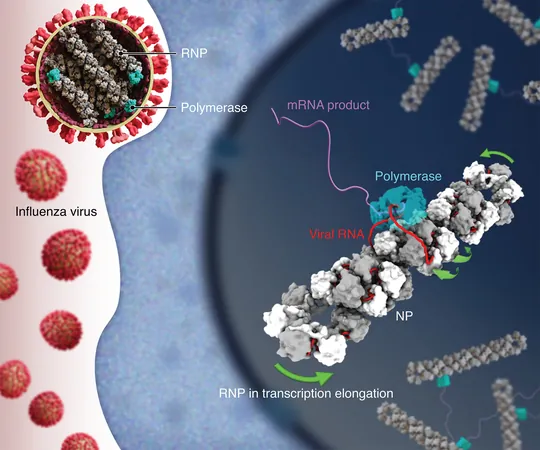
A Game-Changer in Flu Prevention: Non-Seasonal Vaccine Nears Reality!
2025-05-21
Author: Mei
Revolutionary Discovery in Flu Research
Researchers at the University of Pennsylvania have made a groundbreaking discovery that could transform how we fight the flu. They've identified a unique double-helix structure within influenza's ribonucleoprotein complexes that plays a crucial role in how the virus replicates its RNA. This revelation opens the door to developing antivirals that target a stable aspect of the virus, rather than its ever-changing surface.
The Dangers of Seasonal Flu
Every year, seasonal influenza claims between 290,000 and 650,000 lives worldwide. The current vaccines and most antiviral treatments focus on the virus's surface proteins, which undergo rapid mutations. As a result, their effectiveness diminishes significantly over time. In contrast, the core viral machinery, particularly nucleoprotein (NP) and RNA polymerase, has remained largely unexplored, hampering our ability to create broad-spectrum flu medications.
Cutting-Edge Technology at Work
In their recent study titled "Molecular basis of influenza ribonucleoprotein complex assembly and processive RNA synthesis," the researchers employed advanced technologies like cryo-electron microscopy and cryo-electron tomography. These methods allowed them to visualize how NP chains and polymerase work together to produce RNA continuously.
Impressive Findings Unveiled
The analysis of over 17,000 digital micrographs revealed a staggering 516,476 particles of a reconstituted influenza D segment and numerous native influenza A filaments. They achieved a meticulous reconstruction of the viral structure, mapping it at an incredible resolution.
Unlocking Future Treatments
The study details a novel way of organizing NP into a duplex structure, with RNA intricately threaded through it. This revelation indicates a unique method by which the polymerase interacts with the viral helix, potentially allowing the virus to evade immune defenses.
A New Hope in Antiviral Research
In a significant advancement, researchers screened 30 million compounds to find three promising candidates with antiviral properties. Notably, compounds 1 and 5 successfully inhibited H1N1 replication without causing cell toxicity. Meanwhile, another candidate showed promise at lower concentrations but became toxic at higher doses.
A Paradigm Shift in Flu Treatment Strategies
The findings suggest that targeting the tail-loop contact of the polymerase could disrupt the virus's replication process. This innovative approach could lead to the development of pan-influenza medications, shifting the focus from vulnerable surface proteins to the robust core machinery of the virus.
The Future Looks Bright!
As researchers unveil these promising avenues, the prospect of a non-seasonal flu vaccine inches closer to reality. This could be a turning point in the world of flu prevention, offering hope for effective treatments that protect us from the relentless and evolving threat of influenza.




 Brasil (PT)
Brasil (PT)
 Canada (EN)
Canada (EN)
 Chile (ES)
Chile (ES)
 Česko (CS)
Česko (CS)
 대한민국 (KO)
대한민국 (KO)
 España (ES)
España (ES)
 France (FR)
France (FR)
 Hong Kong (EN)
Hong Kong (EN)
 Italia (IT)
Italia (IT)
 日本 (JA)
日本 (JA)
 Magyarország (HU)
Magyarország (HU)
 Norge (NO)
Norge (NO)
 Polska (PL)
Polska (PL)
 Schweiz (DE)
Schweiz (DE)
 Singapore (EN)
Singapore (EN)
 Sverige (SV)
Sverige (SV)
 Suomi (FI)
Suomi (FI)
 Türkiye (TR)
Türkiye (TR)
 الإمارات العربية المتحدة (AR)
الإمارات العربية المتحدة (AR)